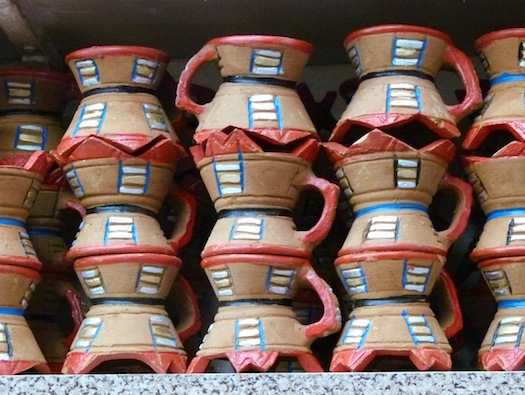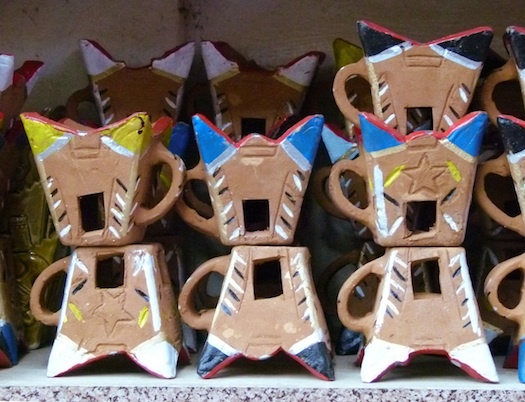
Incense burners displayed in Oman market. All photos: Constantin Boym
Ever since I came to the Middle East, I have been looking for authenticity. Visitors often search out authentic food. As a product designer, I wanted to find local, truly authentic products: things invented, made and used by locals and their families. This proved to be far from easy. The vast marketplace — from souks to supermarkets — offers products that inevitably fall into one of two categories: multiple reiterations of European/American prototypes, or commercial items specifically concocted for tourist consumption.
Then I discovered mabkhara. The proof of these objects’ authenticity starts with the fact that the word does not translate well into English. Most often we use a descriptive expression, “incense burner.” Sometimes, it goes by the confusing word “censer.” (“Distinguish from sensor, censure, and censor,” warns Wikipedia.) In all cases, the word and the object have come to symbolize in Western culture the alien and exotic — a component of Oriental allure, much celebrated in European literature and the arts of the last two centuries.
To be sure, the incense burner has been a familiar presence in many religious services outside the Middle East. In the Catholic Church, a censer suspended on chains is called a thurible, and is used for important masses. In the Greek and Russian Orthodox churches, censers are even more widespread. Every prayer and ritual, from christening to burial, is accompanied by a deacon swinging a panikadilo. In neither religion may a layperson handle the burner; that right is reserved only for the ordained.

In ancient China and Japan, the use of censers was more open-ended and democratic, yet the object clearly maintained spiritual connotations. The Middle Eastern mabkhara, by contrast, is not a religious object. It relates first and foremost to the home, where it is a part of daily family traditions, some of which are uniquely Arabic. Take, for instance, the practice conducted by men and women alike of airing and perfuming their clothes. They accomplish this by standing over a burning censer for a few moments to let the aromatic smoke permeate their garments. When guests are hosted for meals, it is common to burn incense in the majlis (special living room reserved for entertaining). At the end of the evening, the hostess circles the room with the burner, as if to refresh the air. This sends a clear signal that the party is over.
Daily use of incense burners is integral to the sensorial culture of the East. The famous scents of the Orient: frankincense, myrrh, laudanum, sandalwood (oud), which remain the mainstay of all perfume manufacturing, derive from resins produced by desert trees grown only on the Arabian Peninsula. Since ancient times, harvesting and trading these substances has been a source of wealth for the region, and the cause of many attempted conquests. The olfactory has been celebrated in every aesthetic medium from The Arabian Nights to the elaborate secret gardens of Oriental architecture.
Early on, it was discovered that burning incense was the most efficient, and perhaps most spectacular, way to generate and transmit scent. According to Diane Ackerman’s seminal book A Natural History of the Senses, the practice itself has flowed in a current — one that’s wafted downward rather than upward: first incense burning was directed toward the gods, then toward rulers and their court, until eventually it reached the people, becoming a truly popular tradition. The burner has likely followed the same trajectory — evolving from a precious vessel to a basic object for domestic use.

Functional requirements for an incense burner are very simple. The object has to be stable, and it benefits from a handle if it’s meant to be carried. The top, where one places a burning charcoal briquette, must obviously be fire-resistant. Beyond these simple needs, the object can take any imaginable shape and almost any size. And it does. Form does not follow function here. If anything, form follows material and traditional way of making. Every Middle Eastern country has a preferred material, special techniques and a particular formal expression. In addition, there are many contemporary kitsch versions that defy description. (I have started collecting and cataloguing various regional varieties of mabkhara.)
When designers stumble upon a new, relatively unexplored product typology, they immediately start thinking about making a design contribution of their own. Does the world need a new incense burner? What kind of “design improvement” might be made for an object that already serves its purpose so well? Perhaps I need to stay in the Middle East a little longer before I answer these questions.
